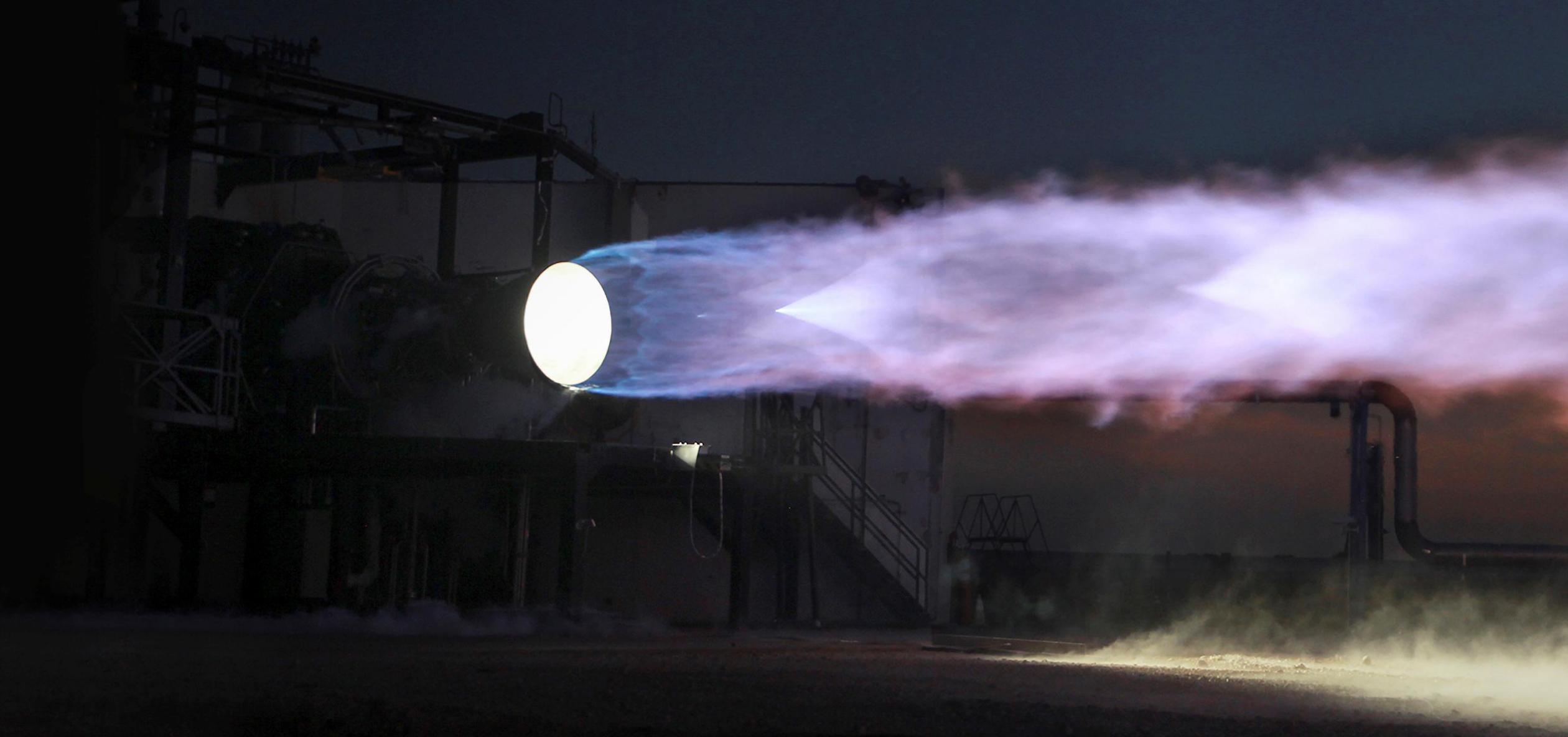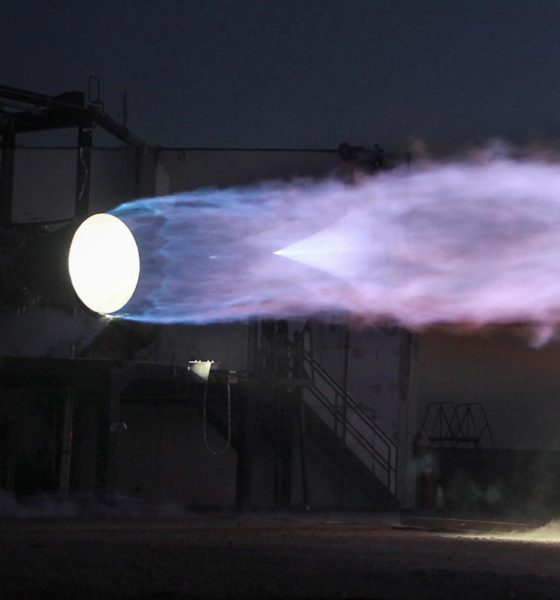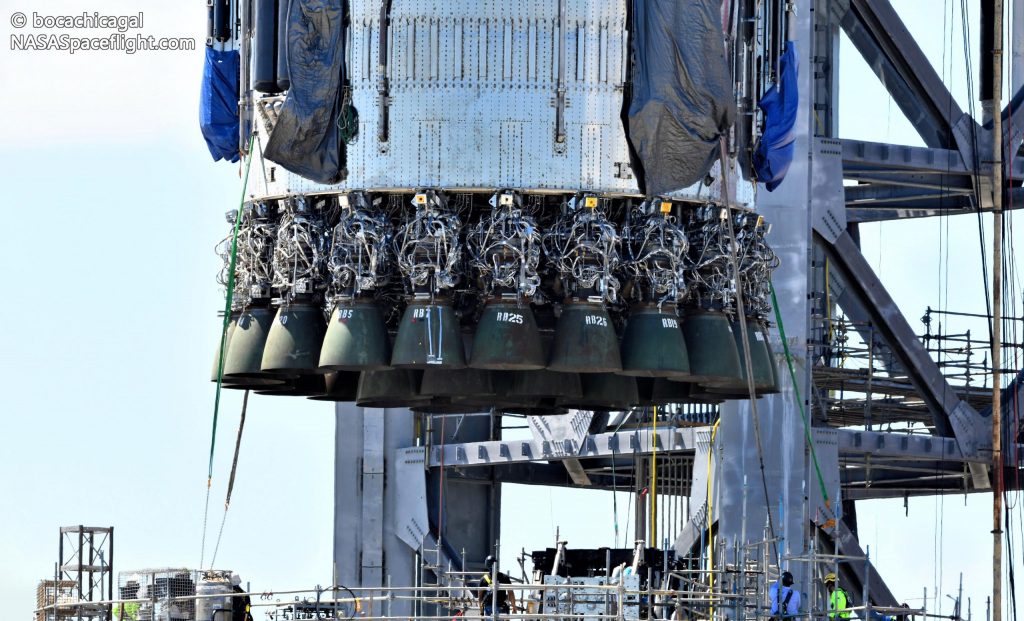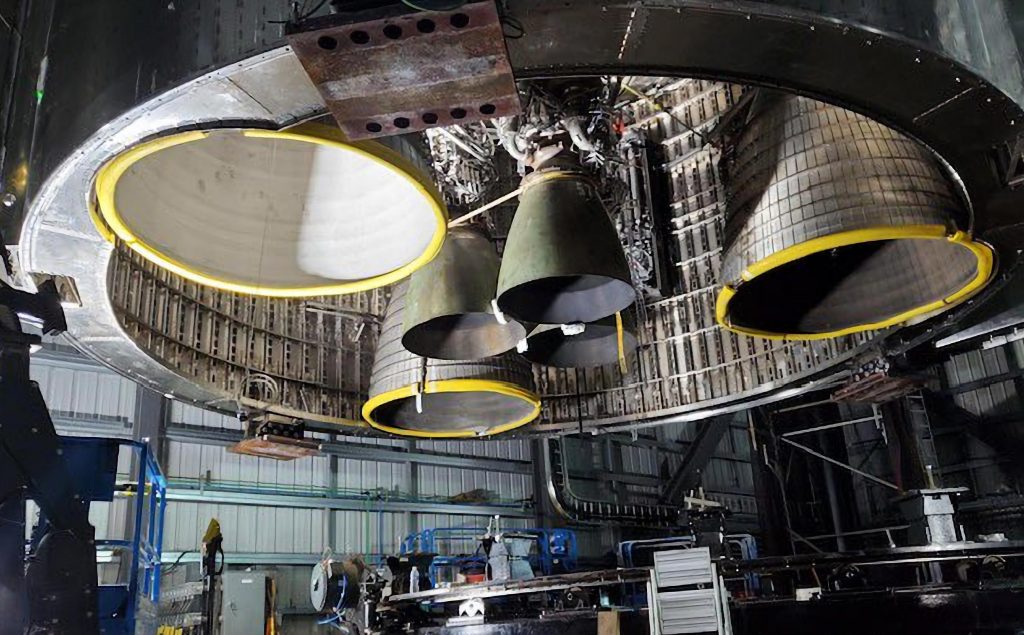

News
SpaceX fires up first upgraded Starship engine
CEO Elon Musk has implicitly revealed that SpaceX recently conducted the first test of Starship’s new Raptor 2 engine.
Aside from kicking off integrated static fire testing of a refined, operationalized version of Raptor, the first prototype may have briefly become the most powerful engine of its kind ever tested before destroying itself. While not quite as successful as the first static fire campaign of a full-scale Raptor 1 engine, which survived several tests, the first Raptor 2 prototype’s early demise is still a routine part of engine development and is the start of a process that should ultimately produce a Super Heavy booster with 50% more thrust than the next most powerful rocket ever flown.
Prior to last weekend, it’s likely that competitor Blue Origin’s BE-4 – still in development and hoped to one day power ULA’s Vulcan and the company’s own reusable New Glenn – was the most powerful methane/oxygen rocket engine ever tested. BE-4 is designed to produce up to 244 tons (~539,000 lbf) of thrust. On its very first static fire, it appears that SpaceX’s first finished Raptor 2 prototype has narrowly stolen BE-4’s crown, briefly generating main combustion chamber pressures of 321 bar (~4650 psi) and as much as 245 tons (~540,000 lbf) of thrust.
To BE-4’s credit, the engine (at least as far as Blue Origin’s sparse public communications go) didn’t destroy itself after its first full-thrust static fire. Raptor 2 wasn’t so lucky and apparently exploded before completing its first test. There’s also some ambiguity as Blue Origin’s own website pegs BE-4 thrust at “2400 kN (550,000 lbf)” when 2400 kilonewtons is actually equivalent to 539,000 lbf. Regardless, designed to produce up to 230 tons (~510,000 lbf) of thrust in flight, Musk has said that Raptor 2 or V2.0 “is a major improvement in simplification” over Raptor 1, which nominally produces up to 185 tons (~410,000 lbf) of thrust at chamber pressures closer to 270 bar (~3900 psi).
It’s not all that surprising, then, that the first Raptor 2 prototype ever completed exploded when SpaceX pushed it to almost 107% of its maximum rated thrust and main chamber pressure during its first test.
Though impressive, SpaceX has technically pushed Raptor 1 prototypes further – and without failure. Musk later indicated that there was some damage present but a fairly young Raptor 1 engine still made it all the way up to 330 bar (~4800 psi) and spent about 10 seconds at chamber pressures above 320 bar without failure during an August 2020 stress test. Still, had the Raptor 2 prototype also made it to 330 bar, it would have produced around 252 tons (555,000 lbf) of thrust – 12% more than its Raptor 1 predecessor.


According to Musk, the main differences between Raptor 1 and Raptor 2 are “much cleaner” plumbing and wire harnesses and a wider combustion chamber throat, which allows the engine to produce more thrust in roughly the same package at the cost of a slight efficiency loss. Over the last two years, the CEO has mentioned the possibility of a power-optimized Raptor variant with up to 300 tons of thrust but in recent months, Musk says SpaceX has decided to keep the Raptor family as streamlined as possible and opted for just two variants – one with a sea-level nozzle (Raptor Center and Boost) and one with a larger vacuum-optimized nozzle (RVac).

Elon Musk
Elon Musk’s X will start using a Tesla-like software update strategy
The initiative seems designed to accelerate updates to the social media platform, while maintaining maximum transparency.

Elon Musk’s social media platform X will adopt a Tesla-esque approach to software updates for its algorithm.
The initiative seems designed to accelerate updates to the social media platform, while maintaining maximum transparency.
X’s updates to its updates
As per Musk in a post on X, the social media company will be making a new algorithm to determine what organic and advertising posts are recommended to users. These updates would then be repeated every four weeks.
“We will make the new 𝕏 algorithm, including all code used to determine what organic and advertising posts are recommended to users, open source in 7 days. This will be repeated every 4 weeks, with comprehensive developer notes, to help you understand what changed,” Musk wrote in his post.
The initiative somewhat mirrors Tesla’s over-the-air update model, where vehicle software is regularly refined and pushed to users with detailed release notes. This should allow users to better understand the details of X’s every update and foster a healthy feedback loop for the social media platform.
xAI and X
X, formerly Twitter, has been acquired by Elon Musk’s artificial intelligence startup, xAI last year. Since then, xAI has seen a rapid rise in valuation. Following the company’s the company’s upsized $20 billion Series E funding round, estimates now suggest that xAI is worth tens about $230 to $235 billion. That’s several times larger than Tesla when Elon Musk received his controversial 2018 CEO Performance Award.
As per xAI, the Series E funding round attracted a diverse group of investors, including Valor Equity Partners, Stepstone Group, Fidelity Management & Research Company, Qatar Investment Authority, MGX, and Baron Capital Group, among others. Strategic partners NVIDIA and Cisco Investments also continued support for building the world’s largest GPU clusters.
News
Tesla FSD Supervised wins MotorTrend’s Best Driver Assistance Award
The decision marks a notable reversal for the publication from prior years, with judges citing major real-world improvements that pushed Tesla’s latest FSD software ahead of every competing ADAS system.

Tesla’s Full Self-Driving (Supervised) system has been named the best driver-assistance technology on the market, earning top honors at the 2026 MotorTrend Best Tech Awards.
The decision marks a notable reversal for the publication from prior years, with judges citing major real-world improvements that pushed Tesla’s latest FSD software ahead of every competing ADAS system. And it wasn’t even close.
MotorTrend reverses course
MotorTrend awarded Tesla FSD (Supervised) its 2026 Best Tech Driver Assistance title after extensive testing of the latest v14 software. The publication acknowledged that it had previously criticized earlier versions of FSD for erratic behavior and near-miss incidents, ultimately favoring rivals such as GM’s Super Cruise in earlier evaluations.
According to MotorTrend, the newest iteration of FSD resolved many of those shortcomings. Testers said v14 showed far smoother behavior in complex urban scenarios, including unprotected left turns, traffic circles, emergency vehicles, and dense city streets. While the system still requires constant driver supervision, judges concluded that no other advanced driver-assistance system currently matches its breadth of capability.
Unlike rival systems that rely on combinations of cameras, radar, lidar, and mapped highways, Tesla’s FSD operates using a camera-only approach and is capable of driving on city streets, rural roads, and freeways. MotorTrend stated that pure utility, the ability to handle nearly all road types, ultimately separated FSD from competitors like Ford BlueCruise, GM Super Cruise, and BMW’s Highway Assistant.
High cost and high capability
MotorTrend also addressed FSD’s pricing, which remains significantly higher than rival systems. Tesla currently charges $8,000 for a one-time purchase or $99 per month for a subscription, compared with far lower upfront and subscription costs from other automakers. The publication noted that the premium is justified given FSD’s unmatched scope and continuous software evolution.
Safety remained a central focus of the evaluation. While testers reported collision-free operation over thousands of miles, they noted ongoing concerns around FSD’s configurable driving modes, including options that allow aggressive driving and speeds beyond posted limits. MotorTrend emphasized that, like all Level 2 systems, FSD still depends on a fully attentive human driver at all times.
Despite those caveats, the publication concluded that Tesla’s rapid software progress fundamentally reshaped the competitive landscape. For drivers seeking the most capable hands-on driver-assistance system available today, MotorTrend concluded Tesla FSD (Supervised) now stands alone at the top.
News
Elon Musk’s Grokipedia surges to 5.6M articles, almost 79% of English Wikipedia
The explosive growth marks a major milestone for the AI-powered online encyclopedia, which was launched by Elon Musk’s xAI just months ago.

Elon Musk’s Grokipedia has grown to an impressive 5,615,201 articles as of today, closing in on 79% of the English Wikipedia’s current total of 7,119,376 articles.
The explosive growth marks a major milestone for the AI-powered online encyclopedia, which was launched by Elon Musk’s xAI just months ago. Needless to say, it would only be a matter of time before Grokipedia exceeds English Wikipedia in sheer volume.
Grokipedia’s rapid growth
xAI’s vision for Grokipedia emphasizes neutrality, while Grok’s reasoning capabilities allow for fast drafting and fact-checking. When Elon Musk announced the initiative in late September 2025, he noted that Grokipedia would be an improvement to Wikipedia because it would be designed to avoid bias.
At the time, Musk noted that Grokipedia “is a necessary step towards the xAI goal of understanding the Universe.”
Grokipedia was launched in late October, and while xAI was careful to list it only as Version 0.1 at the time, the online encyclopedia immediately earned praise. Wikipedia co-founder Larry Sanger highlighted the project’s innovative approach, noting how it leverages AI to fill knowledge gaps and enable rapid updates. Netizens also observed how Grokipedia tends to present articles in a more objective manner compared to Wikipedia, which is edited by humans.
Elon Musk’s ambitious plans
With 5,615,201 total articles, Grokipedia has now grown to almost 79% of English Wikipedia’s article base. This is incredibly quick, though Grokipedia remains text-only for now. xAI, for its part, has now updated the online encyclopedia’s iteration to v0.2.
Elon Musk has shared bold ideas for Grokipedia, including sending a record of the entire knowledge base to space as part of xAI’s mission to preserve and expand human understanding. At some point, Musk stated that Grokipedia will be renamed to Encyclopedia Galactica, and it will be sent to the cosmos.
“When Grokipedia is good enough (long way to go), we will change the name to Encyclopedia Galactica. It will be an open source distillation of all knowledge, including audio, images and video. Join xAI to help build the sci-fi version of the Library of Alexandria!” Musk wrote, adding in a later post that “Copies will be etched in stone and sent to the Moon, Mars and beyond. This time, it will not be lost.”








